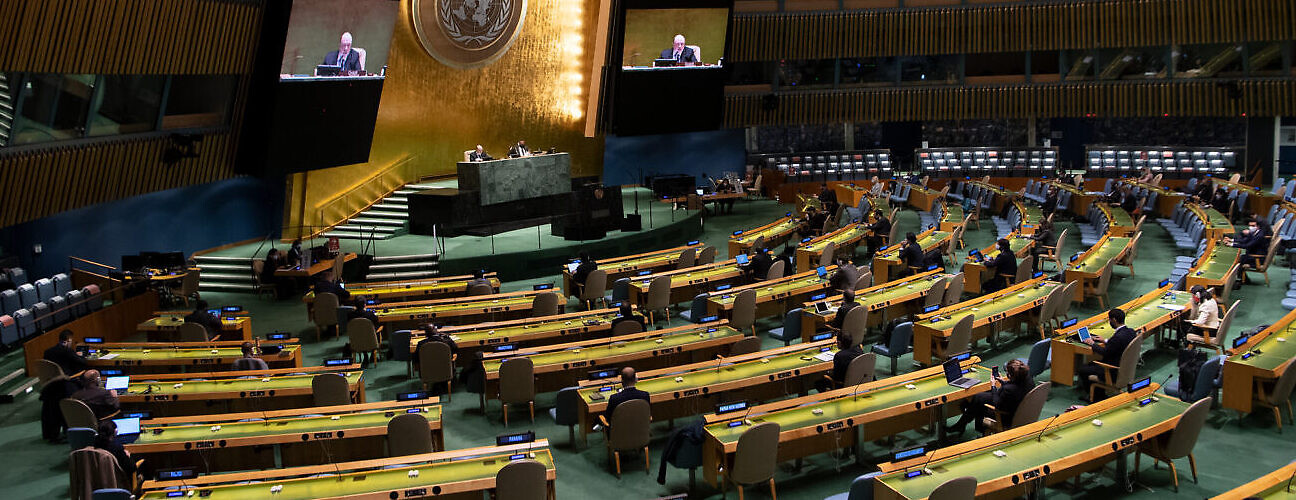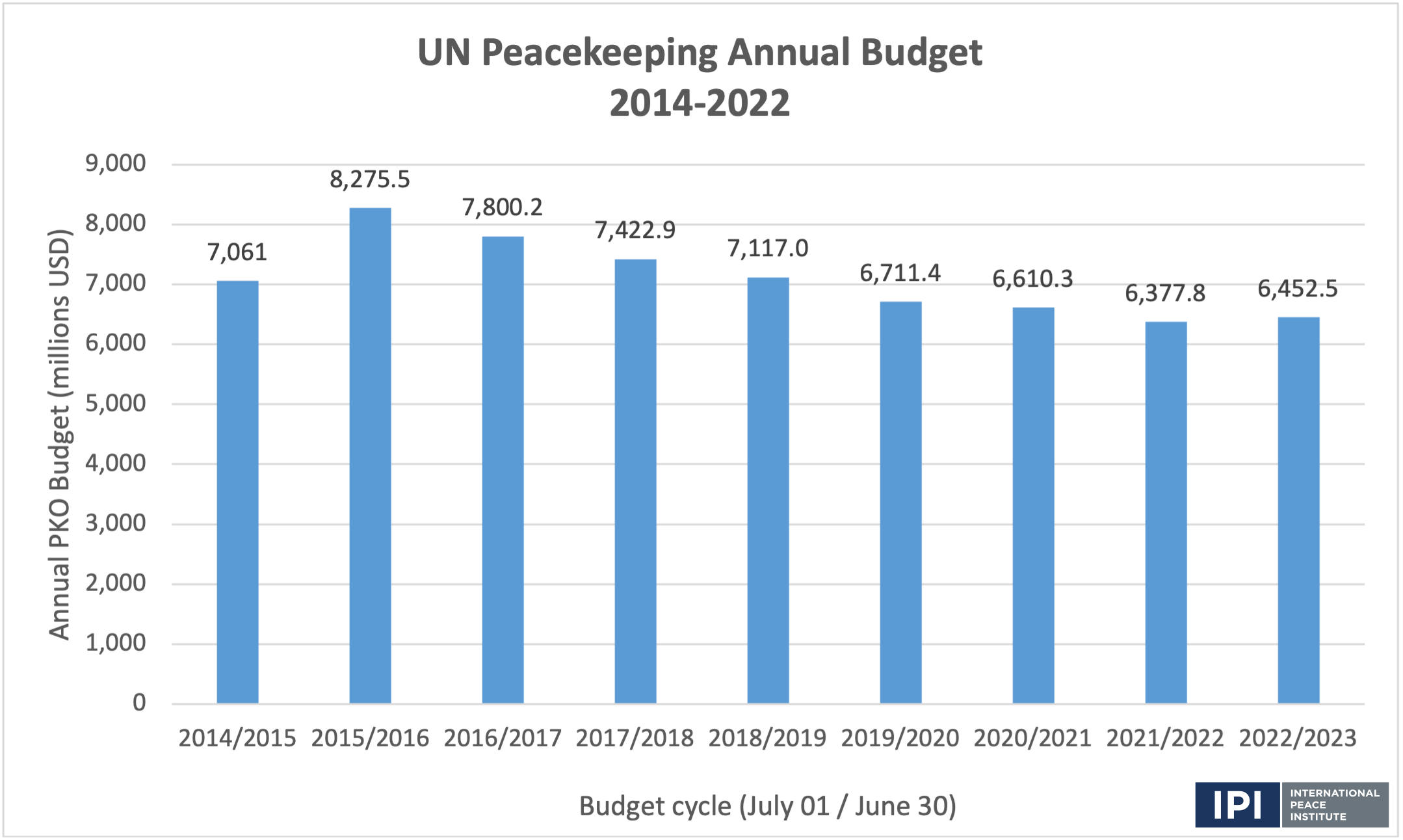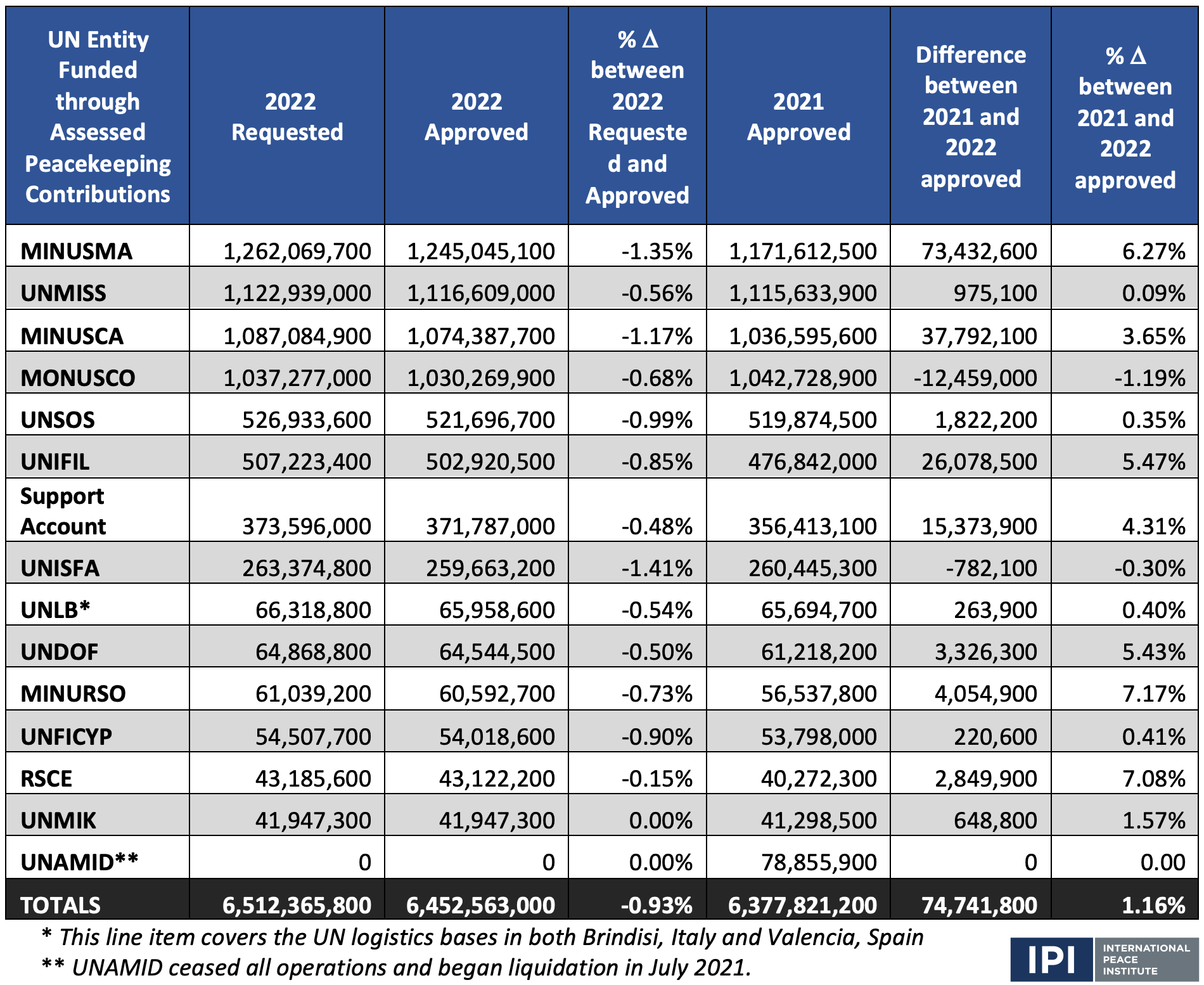A wide view of the ninth plenary meeting of the Fifth Committee of the 75th session of the General Assembly. (UN Photo/Eskinder Debebe)
On June 29th, the United Nations General Assembly (GA)’s Fifth Committee (the specialized body for Administrative and Budgetary issues) approved a $6.45 billion annual budget for United Nations (UN) peacekeeping operations. Diplomats on the Fifth Committee also successfully negotiated a cross-cutting policy resolution, the Committee’s first outcome document of this kind in six years. Although Fifth Committee deliberations typically receive little attention outside of New York, the successful close of this arduous intergovernmental process warrants further reflection.
The mere fact that diplomats concluded these traditionally contentious negotiations on time and without significant political drama is noteworthy. But more importantly, member states agreed to an overall increase in the peacekeeping budget (albeit a small one) for the first time in seven years, and they endorsed a resolution that considers a wide range of operational, financial, and personnel issues impacting UN operations around the world.
The diplomatic consensus required to reach these achievements should not be taken for granted. As palpable divisions among the Security Council’s most powerful members continue to plague the organization’s political efforts and strain the work of its peacekeeping operations, any demonstration of diplomatic unity is cause for celebration. This reflection holds even more weight when considering this moment of heightened geo-strategic tension among global powers (and major voices in the Fifth Committee), including but not limited to the US and China, Russia, and the European Union (EU). But by digging deeper into the newly adopted budget and the policy resolution, it becomes clear that UN peacekeeping still finds itself delicately navigating major divisions and concerns.
Observations about the new 2022 UN peacekeeping budget
The new UN peacekeeping budget is set at $6.45 billion from the period of July 1, 2022 through June 30, 2023, covering ten missions, one support operation, three logistics bases, and the support account that finances headquarters personnel who backstop them (see Table 1). The “big four” multidimensional missions—MINUSMA, UNMISS, MINUSCA, and MONUSCO—continue to consume much of the annual peacekeeping budget, accounting for nearly 70 percent of this year’s $6.45 billion allocation.
The 2022 budget grew by approximately $74 million (1.16 percent) compared to the 2021 budget of $6.37 billion. This is the first time that the UN peacekeeping budget has increased since 2015, when the rapid establishment of peacekeeping missions in Mali and the Central African Republic led the budget to skyrocket by over 14 percent.
Eleven of the thirteen entities funded by the UN peacekeeping budget received more money in 2022 than in 2021. While this would suggest that diplomats are providing missions with more financial support and capacity to implement their mandates, the nearly $74 million budget increase is due to rising operational costs (70 percent) and increased pay for civilian personnel (23 percent). UN peacekeeping, which consumes significant amounts of fuel for its vehicles, energy, and air transportation, has been hampered by the global energy crisis and rising fuel costs around the world. In addition, COVID-19 related global supply chain disruptions and Russia’s war in Ukraine continue to create additional inflationary pressures on the UN budget.
Table 1: 2021 and 2022 Peacekeeping Budget Comparison
Although this was the first year of growth for the UN peacekeeping budget since 2015, the approved budget was still approximately $59 million (0.93 percent) smaller than what the secretary-general had requested in his February 2022 submissions to the Fifth Committee, and approximately $33 million (0.52 percent) smaller than what the Fifth Committee’s advisory body, the ACABQ, had recommended the Committee endorse.
It is standard practice for member states to agree on downward revisions to missions’ budget proposals, and this year was no exception: as a result of various compromises, the UNMIK’s budget was the only one to have received the full allocation requested by the secretary-general, whereas three missions (MINUSMA, UNISFA, and MINUSCA) saw their final budgets reduced by more than 1 percent compared to what had been requested, a relatively large percentage compared with other missions.
In addition to increases in the overall peacekeeping budget, the GA also increased the reimbursement rate for all contingent personnel deployed to UN peacekeeping operations. Member states will now reimburse at $1,448 per uniformed personnel per month, an increase of $20 in the reimbursement rate that was set four years ago. Reimbursements for contingent personnel are an important financial incentive for many troop- and police-contributing countries (T/PCCs) to participate in UN peacekeeping operations. The member state-endorsed rate of reimbursement was approximately $5 less than the officially calculated weighted average of the 2021/22 survey (saving the organization an estimated $5 million per year).
Cross-cutting policy resolution lays down important markers, but also reflects deeper challenges
The cross-cutting policy resolution was the culmination of careful and concerted negotiations across a multi-month period. Diplomats have tried to reach consensus on this kind of resolution every year since their last successful outcome in 2016. However, it is a considerable challenge to maintain consensus among 193 member states on omnibus policy documents about UN peacekeeping. As an example, the GA’s Special Committee on Peacekeeping Operations (the C-34), which has 157 member states, has been unable to adopt its consensus-based substantive reports in 2013, 2019, and 2022.
The cross-cutting policy resolution builds on annual reports and observations from the secretary-general and the ACABQ on these cross-cutting issues. The resolution is structured through subheadings on budget presentation and financial management, personnel issues, and operational requirements. It also features a standalone discussion on special measures for protection from sexual exploitation and sexual abuse (SEA), building on the secretary-general’s implementation of the organization-wide strategy to combat SEA by UN personnel. Considering that this remains a sensitive issue for T/PCCs, it is noteworthy that the guidance on SEA remained in this consensus-based resolution.
This Fifth Committee resolution holds significance for a few reasons. First, it’s the clearest distillation of policy guidance from the Committee, which has otherwise engaged piecemeal on these issues through individual mission budgets. Second, it provides a concrete set of recommendations for both the secretary-general and member states, and provides a more structured way for UN stakeholders to build on a set of common priorities for the coming year. And third, it provides an indication of the issues on which member states feel that the Secretariat needs to demonstrate more progress to justify current expenditure, as well as those priorities where diplomats want the UN to scale up its efforts.
While the resolution covers many issues, there are four worth discussing in greater detail that reflect both peacekeeping’s evolution as well as its long-standing concerns.
Mission planning and performance assessments: Member states clearly desire more concrete and objective evidence on how well missions perform, and whether the UN’s emphasis on integrated planning is producing results. The resolution calls for member states to provide “adequate resources” to support integrated mission planning. It also pays considerable attention to the Department of Peace Operations’ Comprehensive Planning and Performance Assessment System (CPAS), asking the Secretariat to prepare an execution plan for and analysis of CPAS implementation, including lessons learned on mission planning and assessing impact, performance and accountability, and links between CPAS and budget formulation process. This is an important declaration considering that most peacekeeping operations have very small allocations for mission planning structures; compared to previous years when diplomats rejected missions’ requests for more support, this year the Fifth Committee approved new planning officer positions in UNFICYP and UNIFIL.
Gender mainstreaming and the WPS agenda: Member states built on member state commitments and the A4P+ priorities to provide further support to gender mainstreaming in UN peacekeeping and to the WPS agenda. The resolution requests that the UN “improve the mainstreaming of a gender perspective into peacekeeping operations” and the participation of women across all mission activities. It also addresses the role of both the UN and T/PCCs in identifying and removing obstacles to women’s full participation in all areas of peacekeeping missions. These priorities build on a growing body of research that emphasizes the important role of member states in tackling these challenges in missions as well as in national contexts.
Drawdown and transition processes: Like the Security Council and the C-34, the Fifth Committee endorses much of the UN’s strategic and operational thinking around improving mission transitions and recognizes the imperative of “thorough, responsive and advance planning.” It focuses attention on crucial administrative and budgetary complexities of drawdowns and liquidation processes, including the need for adequate personnel to oversee these. It urges the Secretariat to better define the delegation of authority in missions after their Security Council mandate has ended, particularly to avoid situations like in Darfur where previous mission bases were looted or destroyed once UNAMID closed down. It also discusses improvements to how missions dispose of their physical assets, which were among the more scrutinized parts of mission transitions in Haiti and Cote d’Ivoire.
Uniformed components: The Fifth Committee also highlighted two valuable policy issues related to uniformed peacekeepers. First, the resolution addresses the persistent issue of caveats (national restrictions that prevent uniformed contingents from participating in certain mission operations). Member states ask the secretary-general to finalize a “clear, comprehensive and transparent” procedure on caveats, something that has been underway since the Declaration of Shared Commitments was signed in September 2018. Second, the resolution sheds light on the need to improve peacekeeper accommodations, particularly in temporary operating bases. This language belies growing concerns from diplomats and UN officials alike that many uniformed personnel, especially those on the frontlines of protecting civilians, are not provided with either basic necessities or adequate standards of living.
Technology: The cross-cutting policy resolution expands on technology issues in two ways. First, member states acknowledge that technological solutions in UN peacekeeping are important for supporting mandate implementation (including the protection of civilians) and not solely as resources for the safety and security of UN peacekeepers. Considering the multiplicity of Secretariat and system-wide initiatives on technology, this conclusion brings the Fifth Committee more closely in line with other UN member state bodies. Second, unmanned aerial systems (UAS) like drones receive a lot of attention in the resolution. Member states ask the Secretariat to reflect on lessons learned to improve their reliability and cost-effectiveness; build technical capacity within missions to engage with UAVs; and refine procurement practices, information security, and performance indicators.
Will this fleeting moment of consensus last?
Unfortunately, this year’s peacekeeping budget does not make significant investments to help missions better implement their substantive mandates, continuing a broader trend of consolidation. Instead, this low-growth budget offers an injection of operational support so that UN peacekeeping can temporarily withstand a period of economic volatility. It remains to be seen whether this support will be enough to help missions protect themselves and sustain all of their project operations if fuel prices continue rising, or if other inflationary pressures bear down on the global economy.
Furthermore, the consensus reached during this year’s Fifth Committee session is most likely a fleeting moment in time rather than the signal of a new era at the UN. Tough negotiations within and between the General Assembly’s major power blocs produced a favorable outcome in this instance. However, this consensus is unlikely to carry over into next year’s peacekeeping budget process, let alone into other UN bodies or intergovernmental negotiations. Tensions among global powers are likely to become even more daunting over the coming months. And the UN finds itself on the backfoot in many of the countries where blue helmets operate, posing difficult questions about the future of the organization’s most visible tool.
But despite this relatively gloomy outlook for the future, the 2022 budget and the cross-cutting resolution should be recognized for what they are: important steps to help stabilize UN peacekeeping and reinforce progress in its normative doctrine and policy guidance. The ultimate value in these efforts rests in how the Secretariat, missions, outside partners, and member states themselves implement the Fifth Committee’s decisions—which are often treated as the most inviolable of all UN legislative commitments—in pursuit of making UN peacekeeping operations more effective at a critical moment in history.
Daniel Forti is Research Fellow at the International Peace Institute’s Brian Urquhart Center for Peace Operations.







